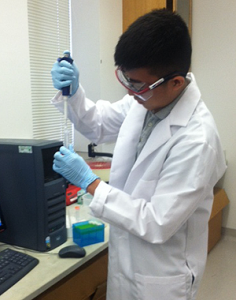A chemistry formula is just letters to be memorized until it becomes the answer to a problematic disease.
This summer, a group of HISD students are interning in various labs at Rice University and finding such answers. Linked Learning, an HISD program that initiates applied and career-based learning, created these internships with help from the Rice Office of STEM Engagement. More than 300 students applied for 12 spots, making the six-week paid internship applicant pool more competitive than that of a top-tier college.
At the Rice labs, each student is paired with a graduate student mentor. The interns are helping their mentors research everything from Alzheimer’s disease to solar cells to volcanoes. After a few short weeks in the advanced labs, the interns can now toss out scientific terms without a hint of a stammer and handle chemical samples as if it were second nature.
Karina Grande, a rising senior at East Early College High School, is assisting a graduate student in the testing of a chemical that could reveal crucial information about Alzheimer’s disease. She knew the basics of chemistry from her high school classes, but at the lab, she is able to witness how chemistry can be used in the pursuit of knowledge.
“It’s cool to see how AP Chemistry applies past high school,” said Grande.
Across the Rice courtyard in another lab, Annum Sadana of Carnegie Vanguard High School and Brenda Gonzalez of Furr High School are building solar cells in order to evaluate which ones transmit electricity the best. This research involves using advanced technology that typical high school students do not have access to, such as a “glove box,” a stabilizing box completely devoid of oxygen and water.
In a microbiology lab, Eastwood Academy student Michael Casio spends his days measuring the bacteria levels in water samples and pondering his own future in a STEM field.
“In school we learn these things in the classroom, but we don’t actually get to do it hands-on,” Casio said. “Getting this exposure to these hands-on activities has really made me think about what kind of career I want.”
No one can currently predict when a volcano will erupt, but Pamela Toledo, a rising senior at Sam Houston Math, Science & Technology Center, is hard at work in a geology lab, using MATLAB, a high-level computing language that develops algorithms, to determine what conditions in volcanic rock predicate an explosion so that someday eruptions can be easily anticipated. Since there will always be unanswered questions, there will always be careers in science.
STEM fields are rife with career opportunities, which is why HISD’s Linked Learning Department teamed up with Greg Adragna and Carolyn Nichol from Rice to create this internship program. Nichol believes that science never reaches a finish line. “There is always more to discover,” she said.
